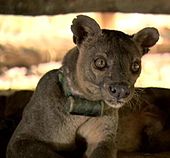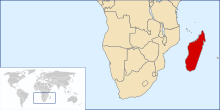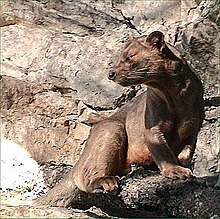Fossa
| Fossa | ||||||||||||
|---|---|---|---|---|---|---|---|---|---|---|---|---|

Fossa ( Cryptoprocta ferox ) |
||||||||||||
| Systematics | ||||||||||||
|
||||||||||||
| Scientific name | ||||||||||||
| Cryptoprocta ferox | ||||||||||||
| Bennett , 1833 |
The fossa ( Cryptoprocta ferox ), more rarely also called the ferret cat , is a species of predator endemic to Madagascar . It is the largest predator on its home island and feeds primarily on primates and other mammals . The loner lives in large territories and is one of the endangered species. Adolescent females form a penis-like clitoris, which disappears again in adult females; this is not known of any other mammal species. The systematic position of the fossa was controversial for a long time, according to DNA studies it is classified in the Madagascan predators (Eupleridae).
features
Trunk and limbs

Fossas resemble a dark, short-legged puma in shape . The body of the fossas is slender and elongated, the legs relatively short. They reach a head body length of 65 to 80 centimeters, with males being slightly larger than females. The tail is almost as long as the body and measures 65 to 70 centimeters, the shoulder height is around 35 centimeters. The average size varies slightly depending on the region, the largest animals live in southwest Madagascar. Fossas reach a weight of 7 to 12 kilograms, with the males generally being slightly heavier than the females. Their fur is short and dense, mostly reddish-brown in color. The belly of males and growing females is colored orange by glandular secretions, in adult females it is beige or cream-colored. Occasionally there are black spots .
The limbs are comparatively short. The spoke is always shorter than the humerus and the shinbone is shorter than the femur . Each foot ends in five toes, which are equipped with retractable claws, claw sheaths like cats are missing. The large pads on the soles of the feet are almost hairless.
Head and teeth
The facial skull of the fossas is relatively short, which together with the large, rounded ears make for a cat-like appearance. The eyes are large and round, the pupils are vertical, and the strongly elongated whiskers (vibrissae) are typical . The nasal mirror is large and well developed.
The tooth formula of the fossa is I 3/3 C 1/1 P 3–4 / 3–4 M 1/1, so it has a total of 32 to 36 teeth. The incisors are relatively small, and the canines, as in all predators, are large fangs . The anterior premolar is very small or completely absent. The rearmost upper premolar and the foremost lower molar (“fangs”) form the “ crushing shears ” found in all land predators . This is very distinctive in strong resemblance to cats. The foremost upper molar is small, the remaining molars are missing. The lower jaw is robust, the masticatory muscles very well developed.
Internal physique and soft tissues
The spine is made up of seven cervical , 13 thoracic , 7 lumbar , 3 sacral and 29 or 30 caudal vertebrae . The collarbone is small. The cardiovascular system and the digestive tract are typically built for predators: the left lung has three and the right four lobes, the stomach is slightly elongated, and the intestine , as in general carnivores, is relatively short.
Males have a very long penis , which is equipped with a large, on average seven centimeters long penis bone ( baculum ). The glans , which takes up almost half of the penis, is spiked with the exception of the tip. The external genital organs of adult females are inconspicuous, while growing females have an elongated, spiked clitoris that is supported by a bony structure ( os clitoridis ). See below for details . Like other Malagasy predators, the females have a pair of uterus (uterus duplex). There are large, sac-like glands (" anal sacs ") on the anus , and other scent glands in the genital region and in the neck. They have three pairs of tummy teats .
distribution and habitat
The original range of the fossas encompassed almost the entire island of Madagascar ; contrary to earlier assumptions, they did not live on the offshore island of Sainte Marie . They inhabit tropical rain and dry forests and are also found in tree savannah areas. They avoid completely unforested areas such as the cleared central highlands or only use them as transit areas. They can be found from sea level up to 2600 meters above sea level. Human settlement has greatly reduced and fragmented its range.
Lifestyle and diet
Activity times and movement
Fossas do not have a distinct day-night rhythm, they are cathemeral and can be active both day and night. Usually, during the hottest and coolest periods of the day and night, they rest in caves or self-dug burrows, for example in the roots of large trees; often they also withdraw into the branches. They often stay on the ground, but they are excellent at climbing and jumping greater distances in the trees, with their long tails serving for balance. On the ground they move on toes (digitigrad) away, in the trees, however, sole tomboyish (plantigrade).
Social and territorial behavior
Fossas are territorial and solitary outside of the mating season. They rub the scent glands of their anal region on the ground or on distinctive tree trunks to mark their territory. The population density is given as 0.18 to 0.26 animals per square kilometer. The territories of the males can be up to 26 square kilometers, those of the females up to 13 square kilometers. Females vehemently defend their territory against same-sex conspecifics; Males are more variable in terms of territory, their territory can overlap with that of other males or females.
food

Fossas are Madagascar's largest predators and strictly carnivorous . They hunt both on the ground and in the trees. Their biggest prey are larval sifakas , which can reach half their weight. Lemurs are an important source of food. Besides Verreaux's sifaka be Edwards' sifaka , dwarf lemur , true lemur , Large bamboo lemur and lemurs eaten. According to a study in western Madagascar, wet-nosed monkeys make up 50% of the diet - in no other predator do primates play such an important role in the diet. Stand by Igeltenreks and other mammals , including Votsotsas , on the menu, as well as reptiles and frogs . Vertebrates make up more than 90% of the prey, the rest are small animals like insects . Sometimes fossas also kill poultry and other small pets.
Prey animals are held down with the claws of the front paws and killed by a bite in the throat or neck. There have been reports of fossas gutting prey and eating the internal organs first.
Reproduction and development
Courtship and copulation
The fossas reproduce from September to November. During this time the female lies down on a conspicuous branch. Often the same place is occupied by several females one after the other, each animal holding the place for one to six days. Several males gather under the tree and sometimes fiercely fight for the mating privilege. The victorious male approaches the female, but is chased away by the female in around a quarter of all cases. From what point of view this happens is unclear. Properties such as weight and age (recognizable by the degree of wear and tear on the teeth) do not play a role. Each female mates several times with several males.
The copulation , which usually takes place on the branch, can last more than two hours (the longest observed copulation took over three hours to complete). After copulation has ended, dogs can also “hang”: the partners cannot separate from each other immediately after copulation has ended. The male fossas can, however, quickly pull their penis out of the female's vagina. The males then often guard their partner for up to half an hour in order to prevent or at least delay copulation with another male.
Birth and rearing of young
The rearing of the young is the sole responsibility of the female. To do this, it relates to a cave in the ground or a self-dug structure, for example in an old termite mound. After a gestation period of about six to seven weeks in the southern summer - December or January - it usually gives birth to two (sometimes three or four) young animals. These weigh around 100 grams, are covered with white-gray fur and are blind. After two to three weeks, their eyes open, and after four and a half months they leave the birth cavity, shortly after which they are weaned. After 12 to 20 months, they leave their mother. Fossas are fully grown at around two years of age; they reach sexual maturity at three to four years of age.
Females can reproduce every two years. The life expectancy of these animals in the wild is unknown; animals in captivity can reach an age of over 20 years.
Temporary masculinization

Temporary masculinization was only observed in fossas among all mammals. Although the females of the spotted hyena have a penis-like clitoris throughout their life , the masculinized features of fossas can only be observed in adolescent females; in adult animals these are regressed again. These characteristics are most clearly pronounced in the second and third year of life, i.e. at the time when the young animals have already been driven away by their mother but are not yet sexually mature.
The most noticeable feature is the enlarged, spiked clitoris. It is supported by a bony structure ( os clitoridis ), similar to the penis bone in males. According to Hawkins et al. this has an average length of 14.5 millimeters in growing females. Of the 10 adult females examined, 6 did not have this bony structure; in the other 4 it was a maximum of 5 millimeters long. None of the adult females had spikes on the clitoris. Another male characteristic is the secretion of a pungent, orange-colored secretion between the throat and the anus, especially in the area between the front and rear legs. This secretion colors the males' belly orange, while adult females have a cream-colored belly. The distinct orange color of the abdomen in growing females fades with increasing age.
Adolescent females show no increased androgen content - in contrast to mammals with a penis-like clitoris throughout their lives. Both testosterone as well as androstenedione and dihydrotestosterone there are no significant differences between adolescent and adult females.
Hawkins et al. assume that growing females are protected in this way from forced copulations - such forced copulations are common in the mammal kingdom and sometimes result in injury or even death of the young female - or that the young female can avoid territorial warfare in this way. Females are more territorial than males and react much more aggressively to other females than to males. The time component would fit this hypothesis, since the characteristics are most pronounced in the period after the mother has been expelled.
Fossas and people
Because of the destruction of their habitat, which has greatly reduced and fragmented the range of these animals, the fossa is an endangered species. It also has a bad rap for sometimes killing pets and is therefore hunted. According to estimates there are fewer than 2,500 adult Fossas, the species is on the IUCN as "Endangered" ( Vulnerable out).
In Madagascar there are some protected areas and national parks where fossas live. Fossas are rarely kept in zoological gardens; the Duisburg Zoo is one of the few zoos, which manages the offspring regularly. This zoo was given the task of coordinating the European Endangered Species Program (EEP) for the fossa. Since the beginning of 2019, the Neunkirchen Zoological Garden has also been participating in the Fossas breeding program.
In Malagasy folklore there are stories that fossas pose a threat to humans. However, there are no reliable reports of attacks on people.
Systematics
External system
Since fossas have the morphological characteristics of different groups of predators, their systematic position was controversial. What they have in common with cats is the short facial skull, the structure of the fangs and the retractable claws. The skull - such as the bulla tympanica - shows strong, diagnostically significant similarities with the crawling cats . With the mongoose they share, among other things, the anal pockets and the arrangement of the cerebral furrows. Due to its anatomical peculiarities, the fossa was usually led in its own subfamily, Cryptoproctinae, which was sometimes assigned to cats, but mostly to crawling cats or mongoose.
According to recent genetic studies, the fossa is included in the group of Malagasy carnivores (Eupleridae). All of Madagascar's predators - which were previously run in different families - descend from a common, mangoste-like ancestor who crossed the Mozambique Strait in the late Oligocene or early Miocene (around 24 to 18 million years ago) . The closest relatives of the fossa are Falanuk and Fanaloka , with whom it forms the subfamily of the Euplerinae.
Internal system
The fossa is the only living member of the genus Cryptoprocta . Several fossils from Madagascar have been described as closely related, extinct species - giant fossa ( Cryptoprocta spelea ) and Cryptoprocta antamba . Morphological studies by Goodman et al. have confirmed the species status of the giant fossa, but see C. antamba - of which only one lower jaw is known - as a malformed individual of the giant fossa.
The generic name Cryptoprocta ("hidden anus") alludes to the large anal sac . Confusingly, the Fanaloka , another Malagasy predator, bears the scientific generic name Fossa . Confusion is probably responsible for this designation, which cannot be changed due to the rules of the International Commission of Zoological Nomenclature (ICZN).
literature
- Ronald M. Nowak: Walker's Mammals of the World . The Johns Hopkins University Press, Baltimore 1999, ISBN 0-8018-5789-9 .
- Michael Köhncke, Klaus Leonhardt: Cryptoprocta ferox . In: Mammalian Species . tape 254 , 1986, pp. 1-5 ( PDF ).
- Harald Schliemann: "Fissipedia" (land predators) . In: Wilfried Westheide, Reinhard Rieger (Ed.): Special Zoology. Part 2: vertebrates or skulls . Spectrum Academic Publishing House, Heidelberg / Berlin 2004, ISBN 3-8274-0900-4 , p. 586-599 ( ISBN 3-8274-0307-3 in the book is incorrect).
- Nick Garbutt: Mammals of Madagascar. A Complete Guide. Yale University Press, New Haven & London 2007, ISBN 978-0-300-12550-4
Individual evidence
- ↑ Steven M. Goodman: Family Eupleridae (Madagascar Carnivores). In: Don E. Wilson, Russell A. Mittermeier (eds.): Handbook of the Mammals of the World. Volume 1: Carnivores. Lynx Edicions, 2009, ISBN 978-84-96553-49-1 , p. 345.
- ^ Clare E. Hawkins and Paul A. Racey: Low population density of a tropical forest carnivore, Cryptoprocta ferox : implications for protected area management. In: Oryx 39 (2005), pp. 35-43.
- ↑ Garbutt (2007), p. 212
- ^ A b Clare E. Hawkins and Paul A. Racey: Food Habits of an Endangered Carnivore, Cryptoprocta ferox , in the Dry Deciduous Forests of Western Madagascar. In: Journal of Mammalogy 89 (1), 2008, pp. 64-74
- ↑ Garbutt (2007), p. 213
- ↑ The whole section follows: Clare E. Hawkins and Paul A. Racey: A novel mating system in a solitary carnivore: the fossa. In: Journal of Zoology. 277, 2009, p. 196, doi : 10.1111 / j.1469-7998.2008.00517.x . It is not known whether the figures given here can also be transferred to other fossa populations.
- ^ A b c The section follows: Clare E. Hawkins, John F. Dallas, Paul A. Fowler, Rosie Woodroffe, and Paul A. Racey: Transient Masculinization in the Fossa, Cryptoprocta ferox (Carnivora, Viverridae). In: Biology of Reproduction, 66 (3), 2002, pp. 610-615. Online edition ( Memento of the original from September 27, 2007 in the Internet Archive ) Info: The archive link was inserted automatically and has not yet been checked. Please check the original and archive link according to the instructions and then remove this notice.
- ↑ Cryptoprocta ferox in the Red List of Threatened Species 2008, accessed on October 30, 2008
- ↑ List at Lefossa.org
- ↑ Information from Duisburg Zoo
- ↑ Garbutt (2007), p. 214
- ↑ for example: G. Veron: La position systématique de Cryptoprocta ferox (Carnivora). Analysis cladistique des charactères morphologiques de carnivores Aeluroidea actuels et fossiles. In: Mammalia, 59, pp. 551-582 (1995)
- ↑ for example: WC Wozencraft: Order Carnivora. In: DE Wilson and DM Reeder, (Eds.) Mammals Species of the World: a taxonomic and geographic reference, Washington, Smithsonian Institution Press 1993, pp. 279-344.
- ↑ e.g. Nowak (1999)
- ^ Anne D. Yoder, Melissa M. Burns, Sarah Zehr, Thomas Delefosse, Geraldine Veron, Steven M. Goodman and John J. Flynn: Single origin of Malagasy Carnivora from an African ancestor. In: Nature 421 (2003), pp. 734-737. PDF
- ↑ Don E. Wilson, DeeAnn M. Reeder: Mammal Species of the World . Johns Hopkins University Press, Baltimore 2005, ISBN 0-8018-8221-4 .
- ↑ Steven M. Goodman, Rodin M. Rasoloarison, Jörg U. Ganzhorn: On the specific identification of subfossil Cryptoprocta (Mammalia, Carnivora) from Madagascar. In: Zoosystema, 26 (1), 2004, pp. 129–143 PDF ( Memento of the original dated November 27, 2006 in the Internet Archive ) Info: The archive link was inserted automatically and has not yet been checked. Please check the original and archive link according to the instructions and then remove this notice.




